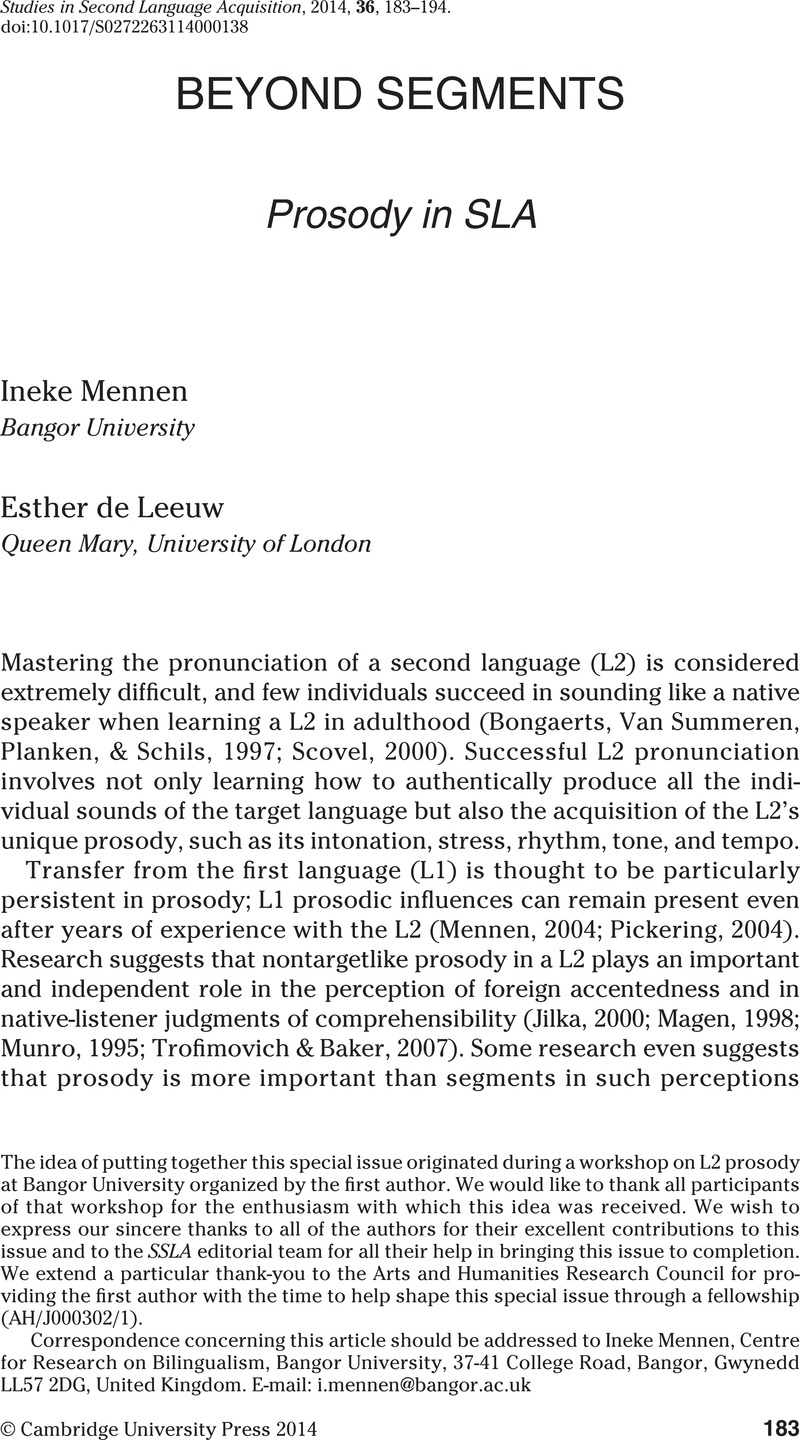Crossref Citations
This article has been cited by the following publications. This list is generated based on data provided by
Crossref.
Nance, Claire
2015.
Intonational variation and change in Scottish Gaelic.
Lingua,
Vol. 160,
Issue. ,
p.
1.
Avanzi, Mathieu
and
Bordal Steien, Guri
2016.
La prosodie du français en contact : présentation.
Langages,
Vol. N° 202,
Issue. 2,
p.
5.
樊, 梦琪
2017.
The Pitch Contour of Declarative Questions of Chinese EFL Learners.
Modern Linguistics,
Vol. 05,
Issue. 02,
p.
151.
Bohn, Ocke‐Schwen
2017.
The Handbook of Psycholinguistics.
p.
213.
纪, 晓丽
2018.
A Survey of Studies in Chinese English Learners’Intonation.
Modern Linguistics,
Vol. 06,
Issue. 05,
p.
755.
Puga, Karin
2019.
Learner Corpora and Language Teaching.
Vol. 92,
Issue. ,
p.
191.
Yuan, Chenjie
González-Fuente, Santiago
Baills, Florence
and
Prieto, Pilar
2019.
OBSERVING PITCH GESTURES FAVORS THE LEARNING OF SPANISH INTONATION BY MANDARIN SPEAKERS.
Studies in Second Language Acquisition,
Vol. 41,
Issue. 1,
p.
5.
Lee, Aleuna
Perdomo, Michelle
and
Kaan, Edith
2020.
Native and second-language processing of contrastive pitch accent: An ERP study.
Second Language Research,
Vol. 36,
Issue. 4,
p.
503.
de Leeuw, Esther
2020.
Lost in transmission.
Vol. 59,
Issue. ,
p.
229.
Nguyễn, Anh-Thư T
2020.
F0 patterns of tone versus non-tone languages: The case of Vietnamese speakers of English.
Second Language Research,
Vol. 36,
Issue. 1,
p.
97.
Perdomo, Michelle
and
Kaan, Edith
2021.
Prosodic cues in second-language speech processing: A visual world eye-tracking study.
Second Language Research,
Vol. 37,
Issue. 2,
p.
349.
Niebuhr, Oliver
2021.
Computer-assisted prosody training: Improving public speakers' vocal charisma with the Web-Pitcher.
Revista da ABRALIN,
p.
1.
Gabriel, Christoph
Grünke, Jonas
and
Karsten, Nils
2022.
Language Development in Diverse Settings.
Vol. 11,
Issue. ,
p.
331.
Hamlaoui, Fatima
Żygis, Marzena
Engelmann, Jonas
and
Quiroz, Sergio I.
2022.
Prosodic Transfer in Contact Varieties: Vocative Calls in Metropolitan and Basaá-Cameroonian French.
Languages,
Vol. 7,
Issue. 4,
p.
285.
Kelly, Niamh
2022.
Change across Time in L2 Intonation vs. Segments: A Longitudinal Study of the English of Ole Gunnar Solskjaer.
Languages,
Vol. 7,
Issue. 3,
p.
210.
Wiklund, Mari
and
Riippa, Anne
2022.
L’intonation des énoncés interrogatifs dans la parole des apprenants finnophones du français.
Journal of French Language Studies,
Vol. 32,
Issue. 3,
p.
383.
Guan, Connie Qun
Meng, Wanjin
Morett, Laura M.
and
Fraundorf, Scott H.
2022.
Mapping Pitch Accents to Memory Representations in Spoken Discourse Among Chinese Learners of English: Effects of L2 Proficiency and Working Memory.
Frontiers in Psychology,
Vol. 13,
Issue. ,
Frost, Dan
2022.
Doing Pronunciation Online: An Embodied and Cognitive Approach Which Puts Prosody First.
Recherches anglaises et nord-américaines,
p.
25.
Colantoni, Laura
and
Mennen, Ineke
2023.
The Effects of Cross-Language Differences on Bilingual Production and/or Perception of Sentence-Level Intonation.
Languages,
Vol. 8,
Issue. 2,
p.
108.
Šimáčková, Šárka
and
Podlipský, Václav Jonáš
2023.
Online guided pronunciation practice helps adult EFL learners improve L2 prosody.
AUC PHILOLOGICA,
Vol. 2022,
Issue. 1,
p.
115.



